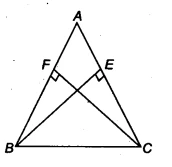NCERT Solutions for Class 9 Maths Exercise 7.2 Question 3

Welcome to this step-by-step guide for Question 3 of Exercise 7.2 from the chapter on Triangles. This problem is a classic proof that demonstrates an important property of isosceles triangles using the rules of congruence.
| Given Information | An isosceles triangle &&\triangle ABC&& with equal sides &&AC = AB&&. Altitudes &&BE \perp AC&& and &&CF \perp AB&&. |
|---|---|
| To Prove | The altitudes are equal, i.e., &&BE = CF&&. |
| Key Concept Used | AAS (Angle-Angle-Side) congruence rule. |
Question 3: ABC is an isosceles triangle in which altitudes BE and CF are drawn to equal sides AC and AB respectively. Show that these altitudes are equal.

How to Prove the Altitudes are Equal 🤔
This proof can be completed in four logical steps by proving that two key triangles are congruent.
- Step 1: Identify the Triangles to Prove Congruent
To prove that the altitudes &&BE&& and &&CF&& are equal, we must first select two triangles that contain these altitudes as sides. The most direct choice is to consider &&\triangle ABE&& and &&\triangle ACF&&. - Step 2: List the Known Equal Parts
Compare the two triangles, &&\triangle ABE&& and &&\triangle ACF&&. We can identify three equal parts:- &&\angle A = \angle A&& (it is a common angle to both triangles).
- &&\angle AEB = \angle AFC&& (both are &&90^\circ&& because &&BE&& and &&CF&& are altitudes).
- &&AB = AC&& (this is given because &&\triangle ABC&& is an isosceles triangle).
- Step 3: Apply the Appropriate Congruence Rule
We have established that two angles and a non-included side of &&\triangle ABE&& are equal to the corresponding two angles and non-included side of &&\triangle ACF&&. Therefore, we can conclude that &&\triangle ABE \cong \triangle ACF&& by the AAS (Angle-Angle-Side) congruence rule. - Step 4: Use CPCTC to Conclude the Proof
Since the triangles &&\triangle ABE&& and &&\triangle ACF&& are congruent, their corresponding parts must be equal. The side corresponding to &&BE&& in &&\triangle ABE&& is &&CF&& in &&\triangle ACF&&. Therefore, &&BE = CF&& by CPCTC (Corresponding Parts of Congruent Triangles).
Detailed Step-by-Step Proof 📝
Here is the formal proof, written step-by-step.
Given:
In &&\triangle ABC&&, we are given that it is an isosceles triangle with &&AC = AB&&.
Also, &&BE&& and &&CF&& are altitudes, which means &&BE \perp AC&& and &&CF \perp AB&&.
This implies that &&\angle AEB = 90^\circ&& and &&\angle AFC = 90^\circ&&.
To Prove:
We need to show that &&BE = CF&&.
Proof:
Let’s consider the two triangles &&\triangle ABE&& and &&\triangle ACF&&.
In &&\triangle ABE&& and &&\triangle ACF&&:
- &&\angle BAE = \angle CAF&& (This is the same as &&\angle A&&, which is a Common angle to both triangles)
- &&\angle AEB = \angle AFC&& (Both are &&90^\circ&&, as BE and CF are given as altitudes)
- &&AB = AC&& (Given that &&\triangle ABC&& is isosceles)
So, by the AAS (Angle-Angle-Side) congruence rule, we can state that:
&&\triangle ABE \cong \triangle ACF&&
Now, since the two triangles are congruent, all their corresponding parts must be equal (CPCTC).
The side corresponding to &&BE&& in &&\triangle ABE&& is &&CF&& in &&\triangle ACF&&.
Conclusion:
&&BE = CF&&
Hence, proved that the altitudes drawn to the equal sides of an isosceles triangle are equal.
Key Concepts Used ✅
- AAS Congruence Rule: If two angles and a non-included side of one triangle are equal to the corresponding parts of another triangle, the triangles are congruent.
- CPCTC: This is the reason we use *after* proving congruence to state that the remaining corresponding parts are equal.
- Altitude: A line segment from a vertex that is perpendicular to the opposite side.
FAQ (Frequently Asked Questions)
Q: What is an altitude of a triangle?
A: An altitude of a triangle is a perpendicular line segment drawn from a vertex of the triangle to the opposite side (or its extension). In this problem, &&BE&& is the altitude from vertex B to side AC, and &&CF&& is the altitude from vertex C to side AB.
Q: What is the AAS congruence rule?
A: The AAS (Angle-Angle-Side) congruence rule states that if two angles and a non-included side of one triangle are equal to the corresponding two angles and non-included side of another triangle, then the two triangles are congruent.
Q: What does CPCTC stand for and when is it used?
A: CPCTC stands for ‘Corresponding Parts of Congruent Triangles are Congruent (or equal).’ It is a reason used in proofs after you have already established that two triangles are congruent. It allows you to state that their remaining corresponding sides and angles are also equal.
Q: Could we use the RHS congruence rule for this proof?
A: Yes, it is possible to use the RHS (Right angle-Hypotenuse-Side) rule by considering triangles &&\triangle BCF&& and &&\triangle CBE&&. In this case, &&\angle BFC = \angle CEB&& (&&90^\circ&&), &&BC = CB&& (common hypotenuse), and &&\angle FBC = \angle ECB&& (angles opposite to equal sides AB and AC). However, the AAS proof with triangles &&\triangle ABE&& and &&\triangle ACF&& is often considered more direct.


